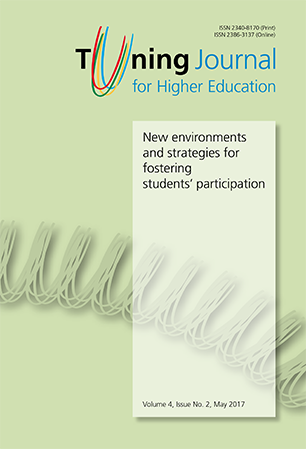Credit Hour System and Student Workload at Alexandria University: a possible paradigm shift
Abstract
The study aims at investigating the perceptions of both academics and students on student workload in Credit Hour System at the Faculty of Education at Alexandria University (Egypt). It uses the wider international experience of higher education reform, including Tuning Africa Project — II, to propose implications for policy and practice on how the real work hours needed by a student to achieve the learning outcomes specified in the curriculum and to pass a course or module are adequately estimated and to contribute to the definition of the basis of a Credit System for Africa. The data have been collected through questionnaires administered to 26 participants: 11 academics (one academic per course) and 15 students (each student surveyed 11 times across all courses of the Professional Diploma in Education). The main findings show significant differences between the perceptions of academics and students on student workload almost across all courses, where students’ estimation of the number of hours needed to complete the independent work during the semester were much higher than that of academics except for fieldwork (site visits). The independent workload as estimated by academics is 62% of students’ estimation. Significant differences were found between the perceptions of students on the number of hours required for each type of independent work across different courses except “preparation and follow-up work for scheduled classes”. The highest average of estimations of the number of hours was given to course N. 11 (World Trends in Quality Assurance Systems); whereas the lowest average was given to course N. 5 (Assessment of Quality in Educational Institutions) across all different types of independent work. Only 36.4% of academics have taken students’ feedback on workload into consideration when planning the workload for their courses. It was also found that 92% of students were not informed about the number of hours planned for independent work at the beginning of the course. In addition, 88% of students were not asked to express their feedback about workload. These findings indicate that there are no unified regulations among academics to the estimation of student workload. It is also made clear that the process of estimating student workload in Credit Hour System at Alexandria University is staff-centred rather than student-oriented as the majority of academics follow traditional methodologies in the estimation of student workload. It is also enunciated clearly that there is marginal coordination between academics teaching in the same programme. It can be concluded that student voice about their workload is not adequately considered as their feedback is not taken into consideration, which can be interpreted in light of the absence of a “paradigm shift” from staff-centred to student oriented approaches to the estimation of student workload.
Published online: 31 May 2017
Downloads
References
“ECTS User’s Guide.” Accessed September 10, 2016, https://ec.europa.eu/education/sites/education/files/ects-users-guide_en.pdf.
Alexandria University. “Alexandria University’s Branch in Republic of Chad.” Accessed June 1, 2016. http://www.portal.alexu.edu.eg/index.php/en/about-au/ branches/chad.
_____.“Alexandria University’s Branch in Sudan.” Accessed June 1, 2016. http:// www.portal.alexu.edu.eg/index.php/en/about-au/branches/south-sudan-2.
Altbach, Philip. “Measuring academic progress: the course-credit system in American higher education.” Higher Education Policy 14 (2001): 37-44.
Cohen, Louis, Lawrence Manion, and Keith Morrison. Research Methods in Education. 6th edition. London: Routledge, 2007.
Dallal, G. E., and L. Wilkinson. “An analytic approximation to the distribution of Lilliefor’s test statistic for normality.” The American Statistician, 40, no. 4 (1986): 294-296 (Correction: 41: 248).
Denzin, K. Norman, and Yvonna S. Lincoln. Handbook of Qualitative Research. London: Sage, 2002.
González, Julia, and Robert Wagenaar, eds. Tuning Educational Structures in Europe II. Universities’ contribution to the Bologna Process. Bilbao: University of Deusto Press, 2005.
Kis, Viktoria. “Quality Assurance in Tertiary Education: Current Practices in OECD Countries and a Literature Review on Potential Effects.” Paper presented as a contribution to the OECD Thematic Review of Tertiary Education, 2005. Accessed July, 1 2012, http://www.oecd.org/dataoecd/55/30/38006910.pdf.
Mackenzie, Noella, and Sally Knipe. “Research Dilemmas: Paradigms, Methods and Methodology.” Issues In Educational Research 16, no. 2 (2006): 193-205.
Meyer, Benedichte Christine. “A Case in Case Study Methodology.” Field Methods 13, no. 4 (2001): 329-325. don: SAGE, 2003.
Noda, Ayaka. “How Do Credit Hours Assure the Quality of Higher Education? Time-Based vs. Competency-Based Debate.” CEAFJP Discussion Paper Series 16-05, Centre d’Etudes Avancees Franco-Japonais de Paris (2016): 1-18.
Siegel, S., and N. J. Castellan. Nonparametric statistics for the behavioral sciences. New York: McGraw-Hill, Inc., 1988.
Stensaker, Bjrn. “Trance, Transparency and Transformation: the impact of external quality monitoring on higher education.” Quality in Higher Education 9, no. 2 (2003): 151-159.
Supreme Council of Universities — Sector Committee for Education. Student Guide for postgraduate studies according to Credit Hour System. Alexandria: El Gomhoreya Press, 2010.
Supreme Council of Universities. “Responsibilities of the SCU.” Accessed March 1, 2016. http://portal.scu.eun.eg/Responsiblities.html.
Tuning Africa — II. “What is Tuning Africa?” Accessed March 20, 2016. http://tuningafrica.org/en/what-is-tuning-africa.
_____.“Second general meeting. Addis Ababa, 29 February — 2 March.” Accessed March 20, 2016. http://tuningafrica.org/upload/evento/editor/doc/2/booklet_ teacher-education_english.pdf.
Wagenaar, Robert. “Educational structures, learning outcomes, workload and the calculation of ECTS credits.” In Tuning Educational Structures in Europe. Universities’ contribution to the Bologna Process. An introduction, 2nd edition, edited by Julia González and Robert Wagenaar, 57-81. Bilbao: University of Deusto Press, 2008.
Yin, K. Robert. Case Study Research: Design and Methods. 3rd edition. London: SAGE, 2003.
Authors are required to sign and submit a copyright transfer agreement after acceptance but before publication of their manuscript. To that effect, they receive, from the Managing Editor of Tuning Journal for Higher Education, a standard copyright assignment form designed along the following lines:
1. Authorship:
The author who signs the copyright transfer agreement must be the sole creator of the work or legally acting on behalf of and with the full agreement of all the contributing authors.
2. Copyright and Code of conduct:
a) Authors warrant that their work is original; has not been previously copyrighted or published in any form; is not under consideration for publication elsewhere; its submission and publication do not violate TJHE Ethical Guidelines for Publication and any codes (of conduct), privacy and confidentiality agreements, laws or any rights of any third party; and no publication payment by the Publisher (University of Deusto) is required.
b) Authors are solely liable for the consequences that may arise from third parties’ complaints about the submitted manuscript and its publication in Tuning Journal for Higher Education (TJHE).
c) Authors grant to the Publisher the worldwide, sub-licensable, and royalty-free right to exploit the work in all forms and media of expression, now known or developed in the future, for educational and scholarly purposes.
d) Authors retain the right to archive, present, display, distribute, develop, and republish their work (publisher's version) to progress their scientific career provided the original publication source (Tuning Journal) is acknowledged properly and in a way that does not suggest the Publisher endorses them or their use of the wortk.
e) Authors warrant that no permissions or licences of any kind will be granted that might infringe the rights granted to the Publisher.
3. Users:
Tuning Journal for Higher Education is an Open Access publication. Its content is free for full and immediate access, reading, search, download, distribution and reuse in any medium or format only for non-commercial purposes and in compliance with any applicable copyright legislation, without prior permission from the Publisher or the author(s). In any case, proper acknowledgement of the original publication source must be made and any changes to the original work must be indicated clearly and in a manner that does not suggest the author’s and or Publisher’s endorsement whatsoever. Any other use of its content in any medium or format, now known or developed in the future, requires prior written permission of the copyright holder.


1.jpg)
1.jpg)
.jpg)
1.jpg)
.jpg)
.jpg)









